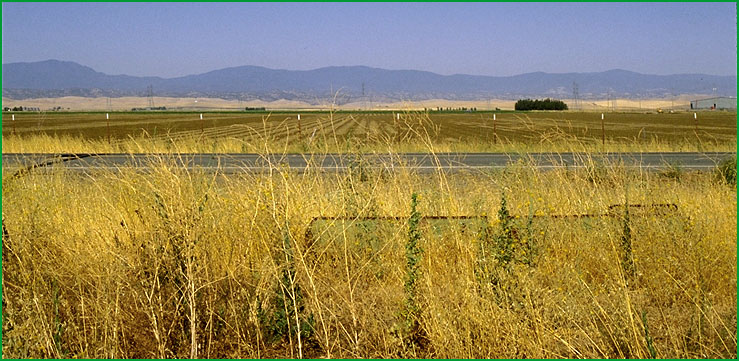 | Yolo Alluvial Fans |
north of Woodland (foreground), M261C (mid) and M261Ca (background) Ś Kerry Arroues |
http://www.fs.fed.us/r5/projects/ecoregions/262ah.htm
This subsection is on a late Quaternary alluvial plain on the lower west side of Sacramento Valley. The climate is hot and subhumid. MLRA 17e.
Lithology and Stratigraphy. This subsection contains Pleistocene and recent alluvium. The alluvium is from granitic, volcanic, sedimentary, and metamorphic rock sources.
Geomorphology. This subsection is mainly late Pleistocene and recent alluvial fans from the northern California Coast Ranges and from hills on the lower west side of the Sacramento River. The subsection elevation range is from about 20 to about 200 feet. Fluvial erosion and deposition are the main geomorphic processes.
Soils. The soils are mostly Typic Xerofluvents, Typic Xerochrepts, and Typic and Mollic Haploxeralfs. Typic Pelloxererts are common in finer sediments, Aquic Haploxeralfs in low areas, and Typic Palexeralfs on older surfaces. The soils are mostly well drained, but some on floodplains are somewhat poorly drained. Most of them are leached free of carbonates. Soil temperature regimes are thermic, and soil moisture regimes are mostly xeric.
Vegetation. The predominant natural plant communities are Needlegrass grasslands, and Valley oak series is common on recent alluvial plains. Fremont cottonwood series occurs along streams, particularly along Cache Creek and Putah Creek.
Characteristic series by lifeform include:
Grasslands: California annual grassland series, Purple needlegrass series.
Forests and woodlands: Fremont cottonwood series, Mixed willow series, Valley oak series.
Climate. The mean annual precipitation is about 15 to 18 inches. It is practically all rain. Mean annual temperature is about 59░ to 60░ F. The mean freeze-free period is about 250 to 300 days.
Surface Water. Streams in this subsection drain to the Sacramento River. All but the larger streams are generally dry during the summer. There are no lakes
